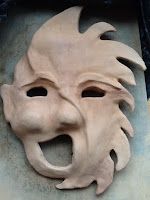What I enjoy about teaching IB is that the program encourages students to go deeper within their studies. To inquire, think critically, and communicate their thought processes. While teaching this unit about the varieties of landscape art to my PYP 4 students, they were able to utilize those skills successfully and develop a deeper understanding of their personal creative approach.
The unit was started with investigating different types of landscape art that have been made by artists throughout history. We broke these types of landscapes down into three categories including representational landscape (or realism), impressionism, and abstract landscape. As a class we viewed artists involved with each category and discussed the differences.
After discussion, the students also learned a new set of vocabulary and how to create perspective within their drawings and paintings. The first task was to create their own landscape using perspective and value as seen in this student's painting and sketchbook work.
The next task was to introduce a new technique and style of painting. After reviewing impressionist artists and famous works, the students were ready to try their own impressionist style paintings. The students used a brand new pencil that had not been sharpened to dip into colors to create the bold dots or brush strokes seen within this style. The students had a lot of fun mixing colors to their landscape with something other than a paint brush!
The final task for this unit was by far the best, according to my students. Together, we took a look at Australian artist John Olsen and his famous abstract landscape paintings. The students discussed the different colors used by this artist and how that influences the feel of what type of landscape is represented.
After discussion, each student was given a picture of a map with an aerial view of a landscape. In their sketchbooks, students designed a line drawing based on the bold lines found within their aerial maps. When their drawing was finalized, the messy (and most fun) part began!
Each student was given a small canvas, glue, and pieces of white tissue paper. The students rolled their tissue paper into a line, dipped the "line" into glue, and arranged the "line" on their canvas as it was in their sketchbook drawing. When all of the gluey lines were dry, the students chose specific colors based on what type of landscape they wanted to represent.
They were so engaged during this assignment you could hear a pin drop! The students loved the final results of their mixed media abstract landscapes and were really impressed with how unique everyone's was. I loved teaching this unit and feel like each student was successful and gained a deeper understanding of the creative process and art history!

























